|
|
|
|
Products mentioned in this Article
--None--
|
|
|
|
|
|
|
|
|
 |
|
|
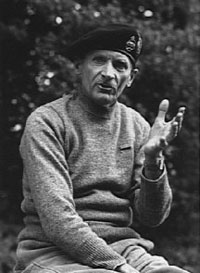 |
The Controversy of Operation Goodwood
By Rich Hamilton
Operation Goodwood…
Operation Goodwood took place between 18 July 1944 and 20 July 1944, but has been surrounded in controversy ever since. The central question of the controversy has always been: “Was a breakout from Normandy the objective of the Goodwood attack?” General Sir Bernard Montgomery and his staff stated plainly that a breakout was never an objective of the Goodwood attack, but his detractors have stated just as plainly that Montgomery did state that a breakout was the objective of Goodwood. Ever since this dispute started on the last day of the attack, ill feelings and cloudy facts have dominated the controversy in the race to choose sides over who is right and who is wrong.
|
|
The truth, however, is far more complicated. In order to fully
understand what happened as a result of Operation Goodwood it is
necessary to examine the Goodwood plan and its conception, what the
objectives were exactly and finally to examine how the controversy
itself developed after the attack.
Strategy
Before the campaign even began, General Montgomery made very clear what the strategy for the Normandy campaign would be. The plan was that the British were to take Caen and the Americans were to take St. Lo. From this point on the British would put enough pressure on the Germans so as to force them to commit the bulk of their forces in the British sector and this would allow the Americans to breakout in their sector. This strategy had served Montgomery well throughout the war and was very similar to the strategy he had employed in his famous victory at the Battle of El Alamein.
Once the breakout occurred then the line would swing east like a giant gate opening with Caen as its anchor.
|
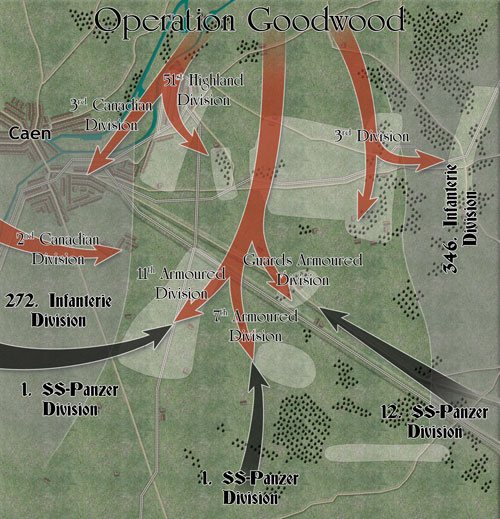 |
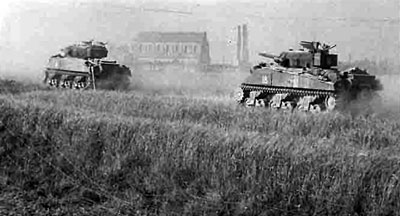 |
This gate would roll up the German Army and then the Allies would be free to drive on Germany. General Montgomery stated this plan very clearly and consistently through out his life after the war, and his actions in the Normandy campaign clearly confirm that taking Caen was the main focus of his efforts. The campaign however did not go as planned.
It was hoped that the British would be able to take Caen on the first day of the invasion of Normandy, but by the time Goodwood was conceived the British Army had been trying to take the city for over a month. |
| Despite the constant pressure and incessant
casualties, the German Army was still tenaciously holding on and the
gains the British were making were both small and costly. So costly in
fact that the British were not able to replace the men they were
losing. One source states that the British were only able to replace
one man for every two they were losing. |
The Plan
At this rate it was only a matter of time before the British Army would falter, and with out the British Army the whole plan was sure to fail. Montgomery had to find a way to keep up the pressure on the Germans and take the city of Caen while significantly reducing the number of casualties his army was taking. These needs would lead to the Goodwood battle plan.
In the month that had passed since the invasion, the British had managed to stockpile large numbers of medium and light tanks in the form of three armored divisions and five independent tank brigades. While the British lacked infantry what they clearly had were tanks.
Also important is the bridgehead over the Orne River that was located to the north and east of the city of Caen. This bridge head was in the form of three bridges over the Orne River and Caen Canal and from here the British could get to the open country behind the city.
|
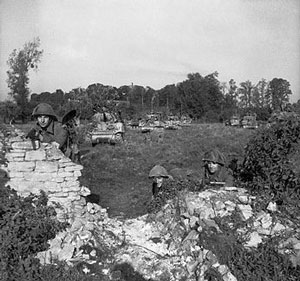 |
The basics of the plan become that the British would use their armour divisions to attack out of the Orne River bridgehead and into the open country behind Caen. From here they would attack the Bourgebus Ridge and at long last capture Caen. Once on the Bourgebus Ridge the British army would now be poised to breakout into the wide-open terrain of the Falaise Gap. The Germans would be forced to respond to this threat in great force or risk being over run.
|
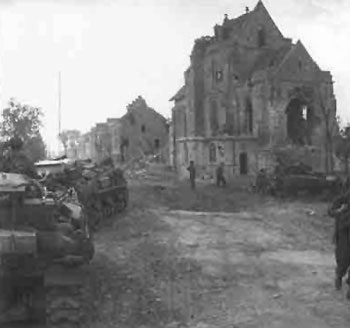 |
Having decided on the plan Montgomery and his staff were faced with several tactical problems that had to be solved. The most important of which was the problem of artillery support. The Orne bridgehead simply did not have enough room for all the forces needed in the attack, which meant there was no room for the masses of artillery that was needed to support the attack. The solution they chose was to employ the British and American air forces to bombard key target areas immediately prior to the attack. They would employ almost 1000 medium and heavy bombers dropping over 15,000 bombs.
After the aerial bombardment the British would employ a rolling artillery barrage to further insure the tank attack was covered as it assembled and attacked after crossing the Orne River. The artillery could only reach so far since it had to be deployed in rear areas due to the lack of room at the bridgehead. This meant that the entire line of attack could not be supported by artillery fire, but the problem was thought to have been solved through the use of aerial bombardment. This view was incorrect.
|
The 16th Luftwaffe Division was the hardest hit, yet its guns were still able to offer great resistance to the attack. The villages were severally damaged as predicted but they were still centres for the strong resistance put up by the German defenders. Even though the massive aerial bombardment had done significant damage, the only real advantage gained was during the period in which the Germans were still recovering from the shock of all those bombs. It turned out that the defenders on the Bourgebus Ridge had suffered little real damage to their combat effectiveness.
|
Failure of Heavy Bombing
The British commanders cannot really be blamed for failing to understand how the use of heavy bombers would affect tactical level combat, as the question of the effectiveness of heavy bombers was misunderstood through out the war. It was argued that a war could be won by the use of strategic bombing alone, but neither the London blitz nor the bombing of German cities had led to any signs of capitulation.
|
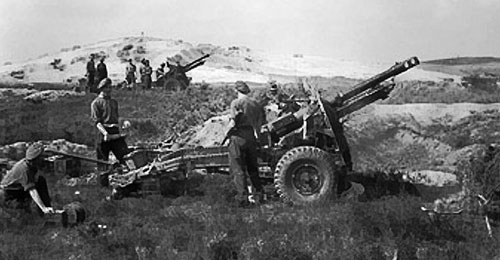 |
This kind of over estimation of the
effectiveness of heavy bombing was seen through out the war and seems
to have affected the thinking of the Goodwood planners. The first time
that heavy bombers had been used for tactical bombardment had only
occurred a few weeks prior to Goodwood during Operation Charnwood.
During Charnwood the British attack occurred hours after the
bombardment when the defenders had fully recovered. The difference in
the tactics between Charnwood and Goodwood is further proof that the
British commanders were learning on the job where this tactic was
concerned.
|
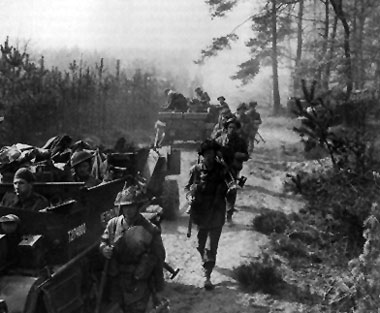 |
It must also be pointed out that the use of tanks was not even thirty years old at the time of Goodwood, and the use of armour in combat was a science that was still in its infancy at the time. British thought on the use of armour was dominated by the stunning effectiveness of the German Blitzkrieg. The armour tactics the British had perfected in the desert of North Africa only confirmed this thought. Prior to Goodwood this was the only real experience the Goodwood planners had in the use of tanks. The belief was that massed armored formations led to dynamic breakthroughs, with infantry being used to attack the tougher positions that the armour had bypassed. This is how the British had won in North Africa and the Goodwood planners were the same men who had led the British to victory there using these tactics.
|
Possibility of Breakthrough and the Goals of the Operation
Capitalizing on the dynamic nature of attacking armour in the open, coupled with the raw power of the heavy bomber, it is only natural that Montgomery and his staff must have thought that a breakthrough was a real possibility. However, a breakthrough was not the primary plan and it was only something that had to be considered because in their estimation it was a very real possibility. We have the advantage of hindsight and can see that a breakthrough was not going to happen under the circumstances of Goodwood, but Montgomery and his staff did not know what was going to happen and had to try to plan for every possibility.
|
With the plan the laid out the objectives were set by Montgomery himself in a document dated 15 July 1944. The primary objective was “to engage the German armour in battle and ‘write it down’ to such an extent that it would be of no further value to the Germans as a basis of battle”. By ‘write it down’ Montgomery was using an accounting term that means to reduce in value. By keeping the German armour engaged or busy in front of the British and causing heavy casualties, he hoped to reduce its value to the German Army by holding it in the British sector so it could not be used as reinforcements in the American sector.
|
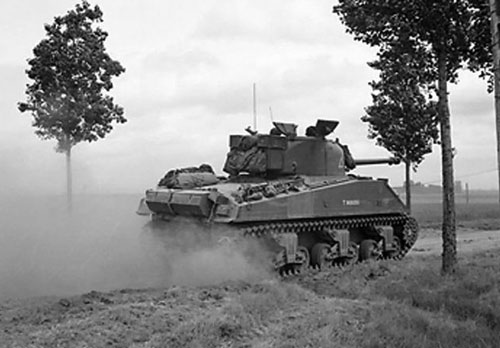 |
|
The second objective was to expand the Orne
river bridgehead, complete the capture of Caen and thus strengthen the
British flank. The final objective was to “generally destroy German
equipment and personnel.”
These objectives would be achieved by taking the Bourgebus Ridge followed by a consolidation of the new position on the ridge. The spearhead of the attack would be led by the 11th Armoured Division with the objectives of the villages of Bras, Hubert-Folie, Verrières and Fontenany. They were supported by the Guards Armoured Division with the objectives of Cagny and Vimont and the 7th Armoured Division with the objective of Garrelles-Serqueville. The Canadian 2nd Corps would launch an attack, code named Operation Atlantic, with the objective of securing the city of Caen.
|
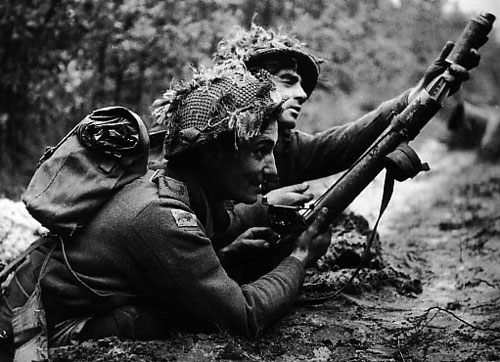 |
He ordered that once the Bourgebus Ridge was under British control “armoured cars should push far ahead to the south towards Falaise and spread alarm.” While the armour formed a firm base on the ridge to hold their gains against the inevitable German counterattack. This was to further alarm amongst the Germans about a breakthrough into the Falaise gap, and thus have them reinforce this sector with armour units.
Key to the Controversy
There was still one more problem that had to be solved, and it may have been the most difficult for Montgomery to solve.
|
He needed to gain the cooperation of the RAF and this is the key to the whole controversy. Once Montgomery had presented the Goodwood plan to Eisenhower then the events that caused the controversy begin to unfold. Montgomery took pains to point out to Eisenhower that he needed “the whole weight” of Allied air power for the plan to be successful, but that once successful the plan would have “far reaching results.” The idea that a breakthrough could occur as a result of Goodwood clearly seems to have intrigued Eisenhower’s staff. Eisenhower himself responded to Montgomery by saying “I am confident that it will reap a harvest from all the sowing that you have been doing during the last few weeks.”
|
From this point on Montgomery seems to have played word games with Eisenhower to some degree and it would appear that the most likely reason was because he was trying to gain the resources needed to execute the attack, mostly in the form of the massive aerial bombardment the plan called for. Because of the ill feelings that already existed between Montgomery and the air force commanders, he truly needed Eisenhower’s support to ensure their full cooperation. At this same time Montgomery’s aide Lt. Col. Christopher Downey told London that the “real objective is to muck up and write off enemy troops”, and that a breakthrough was only something that might happen. By letting Eisenhower believe that a breakthrough would occur Montgomery had laid the groundwork for the controversy that would soon follow, but he did achieve his aim—he gained the full cooperation of both the American and British air forces for his attack.
|
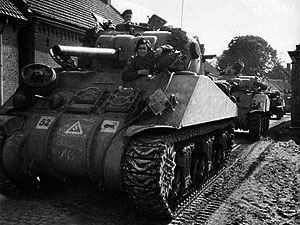 |
After the Operation
On 20 July 1944, when it became clear that the Goodwood attack would make no further gains, the attacks on Montgomery began. One the first people to attack Montgomery over the failure of a breakthrough from the Goodwood attack was Air Marshal Tedder, who clearly hated Montgomery. Eisenhower himself was very angry over the incident and told Montgomery pointedly that no further communication breakdowns would be tolerated. Soon the list of critics of the Goodwood plan would grow and as detractors tried to prove Montgomery’s failure at Goodwood.
|
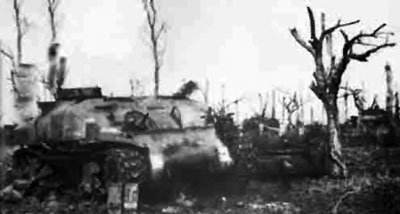 |
What was really said about a breakthrough got lost in a mountain of accusations and out right exaggerations.
In fact, even the casualty figures for the operation are somewhat in dispute. Those who have tried to prove Montgomery and the operation a failure put the casualty rates very high, claiming as much as 700 tanks destroyed. J. T. Sweet in Mounting the Threat, however, estimates that the real figure was the much lower number of 139 tanks destroyed. Examining the results of Goodwood is certainly a case study in how facts and figures can be manipulated to say what ever the writer wants them to say.
|
What we know for sure is, of the objectives set out for Goodwood during the planning stage, all were achieved except the complete capture of the Bourgebus Ridge, which was partially taken. The city of Caen was captured, casualty rates were greatly reduced, large numbers of German reserves were drawn into the British sector away from the American sector, and now the stage was set for the American breakthrough attempt of Operation Cobra.
What about the key question of Goodwood? Was a breakthrough one of the objectives of the operation? The answer is of course yes. While a breakthrough was not the purpose of the attack of Operation Goodwood, a breakthrough was the ultimate objective of the entire Normandy campaign. Every step that was taken, every operation that was launched in Normandy had the ultimate objective of a breakthrough. Goodwood was no different.
|
|
It is the nature of controversy that everyone feels as if they must choose one side or the other and that anyone not advocating a side is somehow side stepping the issues. This view would be in error as truth and reason are also choices one can make. When it comes to the Goodwood controversy, these are the two ideas that have been totally ignored as most of those people writing on the subject have rushed to prove themselves right and those in opposition wrong. God forbid they should let a little thing such as the truth get in their way!
Conclusion
What is the truth? In my opinion Montgomery is as much to blame for the controversy that followed Goodwood as anyone else.
|
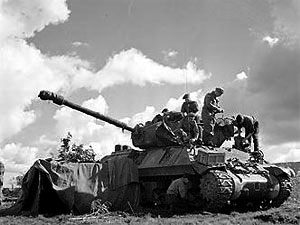 |
He could be difficult and abrasive at times
which had left a long line of enemies and detractors who were waiting
for any opportunity to attack his credibility as a general. These detractors had revelled in Montgomery’s difficulties before Caen, of which Goodwood was just a part. The idea of a breakthrough had come up because the planners really did believe that it was a real possibility, even though it was not the intention of Operation Goodwood. Montgomery talked about this possibility to his superiors because he had to, since they believed it was something that might happen. If such talk led to Montgomery gaining the cooperation and resources he needed for this attack, so much the better, but that does not mean a breakthrough was the objective of Operation Goodwood. Once a breakthrough did not occur it simply became a weapon by which Montgomery’s enemies could attack him.
|
|
Further Reading
Web source used (as a rough guide and counterpoint really): http://en.wikipedia.org/wiki/Operation_Goodwood
Blumenson, Martin, Liberation: World War II, Time-Life Books, Alexandria, VA: 1978.
McKee, Alexander, Caen: Anvil of Victory, St. Martin’s Press, New York: 1964.
Sweet, J.T., Mounting the Threat: July 1944, Presido Press, San Rafael California: 1977.
|
Last Updated On Wednesday, March 5, 2008 by Wayne at Battlefront
|
|
|